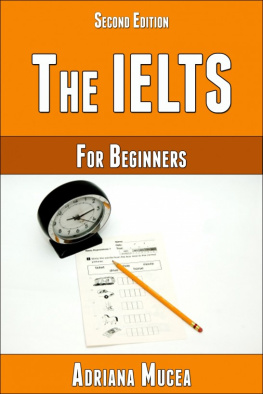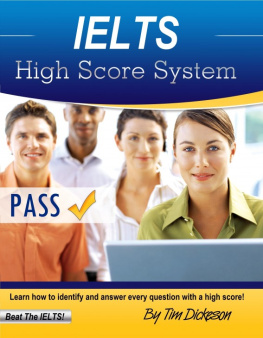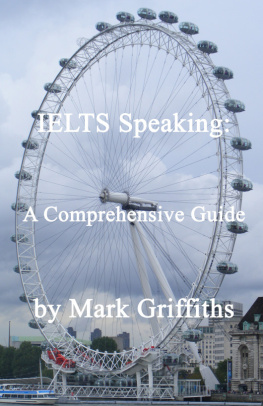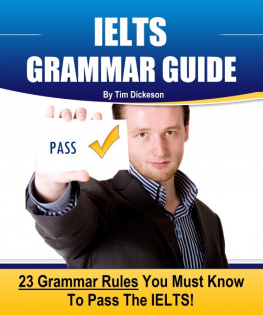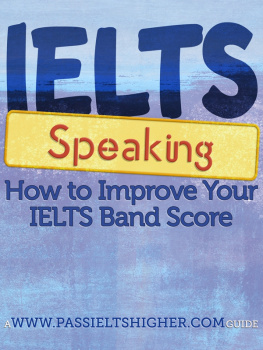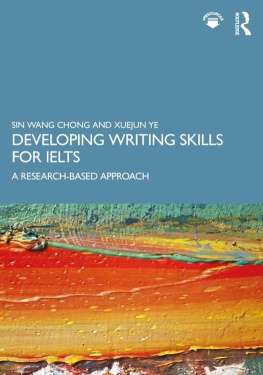The IELTS for Beginners
Second Edition
Adriana Mucea
Copyright 2015 Adriana Mucea
All rights reserved.
Distributed by Smashwords
This ebook is licensed for your personal enjoymentonly. This ebook may not be re-sold or given away to other people.If you would like to share this ebook with another person, pleasepurchase an additional copy for each person you share it with. Ifyoure reading this book and did not purchase it, or it was notpurchased for your use only, then you should return toSmashwords.com and purchase your own copy.
Thank you for respecting the hard work of thisauthor.
Ebook formatting by www.ebooklaunch.com
Contents
In 2012, when the first edition of this bookwas written, the International English Language Testing System,more commonly known as the IELTS test, was the only one accepted byuniversities and other authorities in Australia.
Since then, a few things have changed inthis country. Institutions accept Test Report Forms which are morethan two years old and the test format is nowWriting-Reading-Listening-Speaking whereas in other countries thetest still begins with the Listening part. For the readersconvenience, in this ebook the skills are presented in the originalexam order.
Other things have remained the same. TheIELTS test still has two modules, the General Training and theAcademic and the four skills are usually tested on the same day.The only break the candidates have is after the last written part,while they are waiting to take the speaking test.
Based on the module taken, General Trainingor Academic, the candidates have different questions for Readingand Writing so they have to make sure they are taking the rightone.
For first time candidates preparing for thetest can be a daunting task, particularly when attempting to studyalone, even if there has been an increase in the number of books,websites and blogs which provide information.
This edition aims to help these test takersby providing detailed information on the types of questions andinstructions and offering some techniques to help candidates dealwith these and identify the correct answers. Furthermore, at theend of each chapter there is a section providing even more helpfultips.
The information you will read in thefollowing pages is not exhaustive but it was tried and tested inthe classroom by the authors students and by the author herselfwhen taking the test.
For more information on the IELTS test youcan visit the official website, www.ielts.org .
For the Listening and Reading skills theanswers to the questions have to be written on a special answersheet provided by the invigilators. One side is for the Listeningand the other is for the Reading. Since they look exactly the same,you have to pay attention to the strip marked Listening orReading that comes before the answer boxes to make sure youput the answers on the correct side.
All answers must be written in pencil so ifyou make a mistake you can simply erase it and write the correctresponse.
One thing that candidates have issues withis how and what to actually write on the answer sheet. Many testtakers find all the answers but in the end they cannot be awardedpoints because of what they transfer on this page.
So here are some tips to help you:
You should always read the instructions carefullybefore beginning to answer the questions as they will tell you whatyou are expected to write: True, False, Not Given, letters (A, B,C), numbers, Roman numerals (i, ii, iv) or words (usually no morethan three).
Be mindful not to exceed the word or numberlimit.
Words which are written with a hyphen in English(e.g.: mother-of-pearl) count as one word.
You do not have to write your answers in allcapitals.
You do not have to write with initial capitalunless the words have to be written that way (e.g.: days of theweek, months of the year, names of people and places, calendarevents - Christmas, Easter, etc.)
Do not use symbols such as /, -, or& unless they appear in the text.
You are allowed to use some shortened forms. Forinstance:
- if the answer is 5 per cent you can write it asit is, or as 5%
- if the answer is 5 dollars you can write it asit is, or as $5
However, if the answer is water you cannotwrite it as H2O.
Make sure that you write legibly so that themarkers can understand your handwriting.
Even though many people study English oreven live and work in English-speaking countries before the test,they can still have problems with the listening skill.
Most times it is easier to understandEnglish in face-to-face conversations. You don't have only yourears to rely on but also your eyes, as you can see the otherperson's facial expressions and interpret them. You can also askclarifying questions. But during the IELTS test you will not beable to do this.
The listening test is made up of foursections and each will be played only once. You will hear dialoguesand monologues and you will have to listen for either specificinformation (such as dates, numbers and names) or main ideas. Sometypes of questions might ask you to fill in forms or flow-charts,finish sentences or choose the correct answer out of the three orfour given.
There are some similarities between thissection and the Reading one in terms of the types of questions(multiple choice, fill in the blanks, table/flow-chart/notescompletion, diagram labelling), some word limits and potentialapproaches to handling tasks.
Let's take a look at some types of questionsand what can help you identify the answers faster.
> Fill in aform/plan/map/diagram/notes/summary/sentences with words or numbersfrom the recording.
In this task you need to fill in the blanksas you are listening to the recording. Your answers are expected tomatch the grammar of the sentence where you insert them. Therefore,some small changes may be required, for example, from singular toplural (i.e.: book to books) or from present tense topast (i.e.: dance to danced).
Approach:
Read your instructions carefully to find out whatyour word and/or number limit is.
Read the form or sentences, study the plan or mapto find out what information you already have and to try to predictwhat is missing.
Think of synonyms and paraphrases for the keywords as you may not hear the exact ones on the recording.
> Multiple choice questions
Here you have to select the correct answerout of those given. You may actually hear information related toall the answer choices however, only one is correct.
Approach:
Read the instructions paying attention to thequestion word (e.g.: who, when, why, what), the subject and theverb of the question. They can give you clues as to the type ofanswer you need, for example singular or plural, present or past, anumber, a year or a persons name.
Read all the possible answers, but keep in mindthat only one is correct.
Think of synonyms and paraphrases for all thepossible answers as you may not hear all those exact words.
> Matching statements to a list of optionsprovided (e.g.: names, dates, etc.)
In this exercise you will be given somestatements, which follow the order of the information on therecording and a list of randomly arranged options.
Approach:
Read the statements and read all the optionsprovided.
Find out if you are allowed to use any of theoptions more than once. This would mean that you may be allowed tohave the same answer for more than one question. For instance:
Question 18: A
Question 19: B
Question 20: A
If the options on the list are proper nouns (e.g.:names of people or places) you can expect to hear the same on therecording. However, if the options on the list are common nouns(e.g.: names of usual things) then you may hear synonyms orparaphrases.

